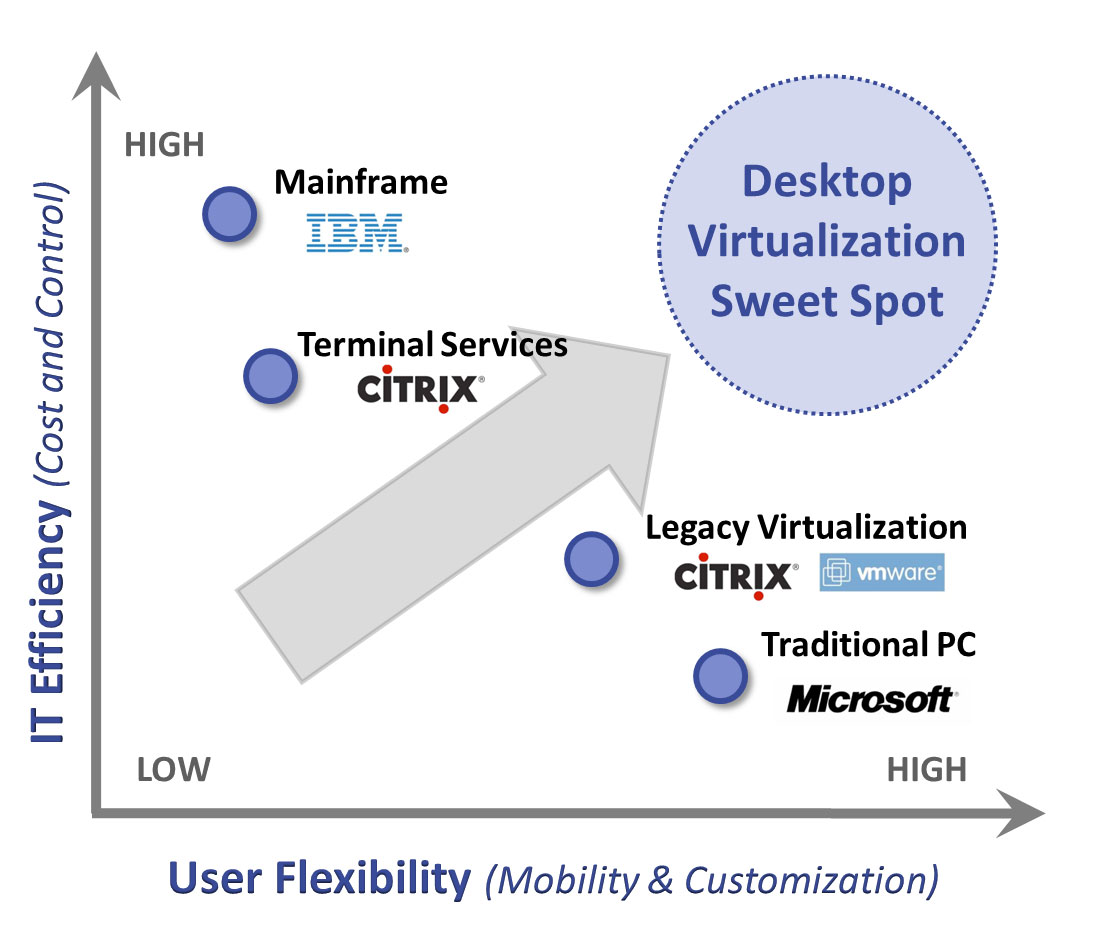Virtual Observer
Aiming for the Desktop Virtualization Sweet Spot
You and my clients have the same challenges and objectives in the pursuit of desktop virtualization.
Back in May, when I kicked off this column, I asked about desktop virtualization--in particular, what's holding you back from deploying it further? Since then, I've been asking customers the same question. While the pace of desktop virtualization hasn't matched industry predictions, the drivers for it have grown more pressing than ever.
Regardless of size and across industries, folks I speak with share a remarkably consistent set of drivers, challenges and objectives for their next-generation desktops:
Centralized and simplified management. The cost of supporting all those new netbooks, smartphones and tablets is starting to overwhelm the IT managers we speak to, and many don't even expect to finish their Windows 7 migrations before its successor ships.
Support for multiple endpoint devices. The user workspace of the future will look a lot more like a smartphone or tablet than a traditional fat PC, with applications driving infrastructure choices--instead of the other way around. The traditional OS-centric view of the user workspace (tied to Windows, for the most part) is in rapid decline, and IT must take a user's-eye view of the desktop moving forward.
Consistent performance regardless of location. Whether users are on a main office LAN, working at a branch office, on the road or at home, they expect to have their personalized desktop environment plus quick access to all the applications and current data required to do their jobs.
Rock-solid data and application security. With virtualized desktops, sensitive corporate data and applications are safely retained on servers within the corporate firewall, or packaged into virtual containers for off-line use (on laptops, for example). Customers report that enhanced security is as important as simplified management when it comes to justifying a desktop virtualization project.
Leverage cloud computing economics. The service-based economics offered by cloud computing--elastic resources, pay-as-you-go consumption, metered usage--can apply to both internal and external IT, but only when the infrastructure is built on a service-based computing foundation. New desktop virtualization solutions must be designed from the ground up for such a service-based delivery model, whether delivering a single application as a service (the SaaS model) or the entire desktop as a service (the emerging DaaS model).
In short, the next-generation desktop must be user and performance driven, rather than operating system or device-driven. Users--especially younger ones--have become increasingly comfortable with consuming applications and data that do not reside on their physical workstations. New desktop virtualization solutions must now help IT departments become just as comfortable delivering these resources the same way.
Overcoming the Desktop Dilemma
In short, the fundamental desktop dilemma--which isn't new--is the need to simultaneously satisfy two competing demands: user mobility and customization versus IT control and efficiency. Historically, giving users more options to personalize their workspaces and take them on the road have come at a high price for IT operations: less control, more security risk, and complex management. Starting with terminal services, IT gave users a bit more flexibility while retaining pretty much full application control. VDI solutions such as VMware View and Citrix XenDesktop started from the other end: attempting to retain the user flexibility and experience of a desktop PC, while increasing IT control.
But in my view, no single desktop transformation technology alone--application streaming, hosted desktop virtualization (VDI), local desktop virtualization, etc.--has yet to reach the sweet spot, optimizing both user flexibility and IT cost efficiency. This must be the goal of the next generation of desktop virtualization solutions.
 |
Figure 1. Desktop virtualization vendors, measured for IT Efficiency vs. User Experience. (Click image to view larger version.) |
Hitting Your Sweet Spot
Despite the concurrent challenges of building for the next-generation desktop at the same time as dramatic shifts in user expectations and devices are underway, significant desktop virtualization projects are happening. To deliver the benefits your business expects, try to learn from those who've gone before you. The best guidelines for success, based on my conversations with customers, include:
Know your users. Use passive monitoring tools like Liquidware Labs' VDI assessment tool to determine not what users say they need or what you think they need, but what they actually use. This will allow fact-based conversations about requirements. Focus on younger workers to understand mobility requirements better.
Align your Windows 7, cloud and mobile computing strategies. Try to kill several birds with one budget stone. Don't plan for a Windows 7 upgrade without looking seriously at virtualizing non-compliant apps, or without looking at delivering the entire Windows 7 environment virtually. And plan for a mobile strategy around desktop virtualization now--not after you have an influx of unmanaged iPads floating around the office.
Keep current on desktop virtualization solutions. VMware, Citrix, and Microsoft continue to jostle for a leadership position, with each stressing a different architectural approach (datacenter-focused, client-focused, and app-focused, respectively, with some cloud sprinkled throughout). But emerging all-in-one vendors are shaking things up. Virtual Bridges VERDE suite leverages the KVM hypervisor and supports users while connected, off-line and in branch modes. VERDE selects the optimal display protocol automatically based on available bandwidth at connect time, in order to deliver a consistent, personalized desktop across multiple use cases from a single unified management console. Others to watch include Desktone, MokaFive and Wanova.
Tomorrow's desktop is evolving as fast as we can evaluate solutions to deliver it. Stay close to your user's evolving requirements, and stay closer to your vendors.
About the Author
A senior analyst and virtualization practice lead at Taneja Group, Dave Bartoletti advises clients on server, desktop and storage virtualization technologies, cloud computing strategies, and the automation of highly virtualized environments. He has served more than 20 years at several high-profile infrastructure software and financial services companies, and held senior technical positions at TIBCO Software, Fidelity Investments, Capco and IBM. Dave holds a BS in biomedical engineering from Boston University and an MS in electrical engineering and computer science from MIT.